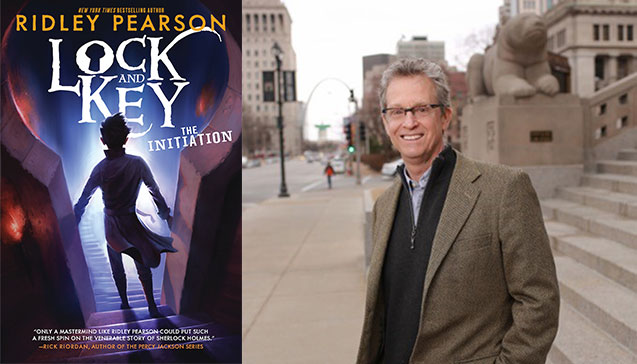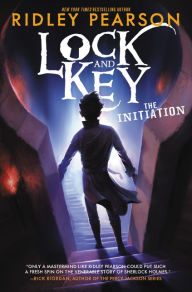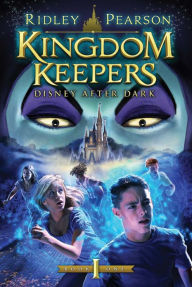The Initiation Author Ridley Pearson on Writing Mysteries, Creating Villains, and Doing Your Homework

Fans of author Ridley Pearson’s bestselling Kingdom Keepers series know that he writes middle grade books filled with adventure, riddles, and breakneck twists and turns. The Initiation, the first novel in his new Lock and Key trilogy, is a fascinating origin story that explores the early lives of Arthur Conan Doyle’s detective Sherlock Holmes and his burgeoning nemesis, James Moriarty, when they encounter each other at a boarding school as teenagers. Pearson was kind enough to share some insights into his writing process, as well as a few of the novelists who have influenced him throughout his extraordinary career, with The B&N Kids’ Blog.
Inspiration isn’t a bolt of lightning through the window. It’s the product of doing your homework and thinking through your story. My homework began with Arthur Conan Doyle—it was he, along with James Crumbly and John D. McDonald, who exerted the most influence over my desire to write crime stories. Doyle’s use of exquisite detail—a certain wooden cane from India or a specific kind of military boot—enthralled me.
Long after my infatuation with Doyle, and just before Michael Connelly and Patricia Cornwall burst onto the publishing scene with their terrific novels, my editor at the time, Brian DeFiore, surreptitiously handed me an early manuscript of Thomas Harris’s The Silence of the Lambs, and told me to read his Red Dragon first. Weeks later, I called Brian and lavished him with praise for opening my eyes to such storytelling. He asked me if I could “write something like that” for him. The result was Undercurrents, my first thoroughly researched, forensically-oriented serial killer novel. It was one of the first serial killer novels published in the wake of Thomas Harris, and my sales soared. I was a bestselling novelist. And it all started with Arthur Conan Doyle.
The Initiation (Lock and Key Series #1)
The Initiation (Lock and Key Series #1)
In Stock Online
Hardcover $17.99
I remained a (re)reader of Doyle’s work in the years to come, returning to it like a student to a favorite professor. I keep collections of his short stories in my bookshelves to this day, and have always been drawn to the character of Holmes’s nemesis, Professor Moriarty. Moriarty is only mentioned in two of the works (a third came later), and Doyle said in interviews that he created Moriarty simply to find a way to get rid of Holmes. It was Moriarty’s character, however, to which I kept returning—the real mystery I wanted to work out for myself.
How did Moriarty become Moriarty? How does a normal boy develop into the world’s greatest criminal mastermind? After years of writing hero arcs for younger readers, here was an opportunity (suggested by David Linker at Harper Collins) to craft a “reverse hero arc”—the devolution of a character.
I reread Doyle’s A Study in Scarlet and stumbled upon the Scowrers, an international band of thieves and ne’re-do-wells, and wham! the arc was there. Story is all about character, and what David was asking for was all about character. With the introduction of the idea of a criminal gang with European roots operating in America, I was hooked. David wanted the story set in present time and in the U.S., I’d been grappling for a way to connect the dots. Arthur Conan Doyle did it for me! I was off and running (or writing).
Again, I did my homework, drawing upon classic mystery novelists such as Agatha Christie and Wilkie Collins for inspiration.
For me, the process of writing an Agatha Christie styled mystery, meant knowing, “who-done-it” before starting the novel. Basically, structuring the story backward. I have no idea if Christie or Doyle worked that way, but knowing the ending allows the writer to make his or her detective seem ingenious in sifting through suspicions and suspects. It also allows for red herrings and McGuffins to be planted throughout. By knowing how the story will end, the writer can start there and run a string back to the start of the story.
I remained a (re)reader of Doyle’s work in the years to come, returning to it like a student to a favorite professor. I keep collections of his short stories in my bookshelves to this day, and have always been drawn to the character of Holmes’s nemesis, Professor Moriarty. Moriarty is only mentioned in two of the works (a third came later), and Doyle said in interviews that he created Moriarty simply to find a way to get rid of Holmes. It was Moriarty’s character, however, to which I kept returning—the real mystery I wanted to work out for myself.
How did Moriarty become Moriarty? How does a normal boy develop into the world’s greatest criminal mastermind? After years of writing hero arcs for younger readers, here was an opportunity (suggested by David Linker at Harper Collins) to craft a “reverse hero arc”—the devolution of a character.
I reread Doyle’s A Study in Scarlet and stumbled upon the Scowrers, an international band of thieves and ne’re-do-wells, and wham! the arc was there. Story is all about character, and what David was asking for was all about character. With the introduction of the idea of a criminal gang with European roots operating in America, I was hooked. David wanted the story set in present time and in the U.S., I’d been grappling for a way to connect the dots. Arthur Conan Doyle did it for me! I was off and running (or writing).
Again, I did my homework, drawing upon classic mystery novelists such as Agatha Christie and Wilkie Collins for inspiration.
For me, the process of writing an Agatha Christie styled mystery, meant knowing, “who-done-it” before starting the novel. Basically, structuring the story backward. I have no idea if Christie or Doyle worked that way, but knowing the ending allows the writer to make his or her detective seem ingenious in sifting through suspicions and suspects. It also allows for red herrings and McGuffins to be planted throughout. By knowing how the story will end, the writer can start there and run a string back to the start of the story.
Disney after Dark (Kingdom Keepers Series #1)
Disney after Dark (Kingdom Keepers Series #1)
By
Ridley Pearson
Illustrator
Tristan Elwell
In Stock Online
Paperback $8.99
Then, right from the start, the writer can take the reader on any number of intentional or unplanned detours along the way, as long as the reader is returned to the string. The best of these stories gives the reader everything he or she needs to solve the crime along with the detective. It is the seeding of the clues that pulls it all together. If done cleverly enough, the reader sees the clues but doesn’t recognize them, won’t yet connect them.
Contemporary storytelling, edgier and more visceral, evolved mystery a step further—turning it into suspense. Beginning with Chandler and continuing through John D. McDonald, James Crumley and so many others, the elements of the plot structure started to change—readers didn’t always get all of the pieces at once; authors would hold back some clues. But like the classics, the reader joined the protagonist on the investigative journey. As Al Zuckerman, the legendary agent, once told me: mysteries are about who-done-it; suspense thrillers are about who-will-prevail.
I drew upon this concept to write the Lock and Key trilogy, three stories, each with an underlying mystery, each coming to a head to determine that one question: who will prevail? What’s fun and different about this series is that it too needs to ultimately resolve a bigger, three-book arc, and to answer the question of who will prevail in the entire series. Boxes within boxes.
Ultimately, the inspiration for Lock and Key wasn’t a bolt of lightning through a window. It was, however, a window of opportunity provided by a story, and the culmination of years of research and inspiration. Drawing on the Doyle legacy and weaving it together with modern story-telling techniques and bits and pieces from “homework” done over the years, Lock and Key began with finding the point of view characters and their voice(s), and fulfilling the promise to the reader that “this will be worth your time.”
Storytelling is a tradition, a legacy—something that’s been passed, one writer to the next. We are only re-inventors. We reengineer forms and concepts that have been around since the Greeks discovered drama out of the process of putting words to “paper.” We continue laying the string. We pass the spool, one to another, tie our own string to the end, and keeping laying out the spool. The fun is in the unrolling; the weaving, the finding of inspiration in the past as much as in the imagination, and letting it shape a new story from the old. It is my joy, as a writer, to discover this story, and to share it with the world.
The Initiation (Lock and Key series Book 1) is on B&N shelves September 20.
Then, right from the start, the writer can take the reader on any number of intentional or unplanned detours along the way, as long as the reader is returned to the string. The best of these stories gives the reader everything he or she needs to solve the crime along with the detective. It is the seeding of the clues that pulls it all together. If done cleverly enough, the reader sees the clues but doesn’t recognize them, won’t yet connect them.
Contemporary storytelling, edgier and more visceral, evolved mystery a step further—turning it into suspense. Beginning with Chandler and continuing through John D. McDonald, James Crumley and so many others, the elements of the plot structure started to change—readers didn’t always get all of the pieces at once; authors would hold back some clues. But like the classics, the reader joined the protagonist on the investigative journey. As Al Zuckerman, the legendary agent, once told me: mysteries are about who-done-it; suspense thrillers are about who-will-prevail.
I drew upon this concept to write the Lock and Key trilogy, three stories, each with an underlying mystery, each coming to a head to determine that one question: who will prevail? What’s fun and different about this series is that it too needs to ultimately resolve a bigger, three-book arc, and to answer the question of who will prevail in the entire series. Boxes within boxes.
Ultimately, the inspiration for Lock and Key wasn’t a bolt of lightning through a window. It was, however, a window of opportunity provided by a story, and the culmination of years of research and inspiration. Drawing on the Doyle legacy and weaving it together with modern story-telling techniques and bits and pieces from “homework” done over the years, Lock and Key began with finding the point of view characters and their voice(s), and fulfilling the promise to the reader that “this will be worth your time.”
Storytelling is a tradition, a legacy—something that’s been passed, one writer to the next. We are only re-inventors. We reengineer forms and concepts that have been around since the Greeks discovered drama out of the process of putting words to “paper.” We continue laying the string. We pass the spool, one to another, tie our own string to the end, and keeping laying out the spool. The fun is in the unrolling; the weaving, the finding of inspiration in the past as much as in the imagination, and letting it shape a new story from the old. It is my joy, as a writer, to discover this story, and to share it with the world.
The Initiation (Lock and Key series Book 1) is on B&N shelves September 20.

